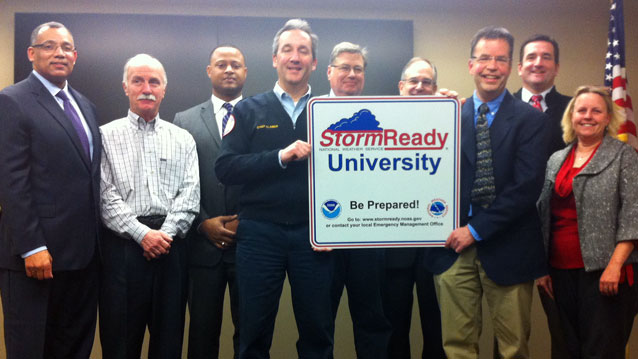EVANSTON, Ill. --- The National Weather Service (NWS) recognized Northwestern University Jan. 28 for achieving a high level of emergency readiness for storm-related crises and presented University Police and other Northwestern leaders with a special award.
The University was recognized as a “StormReady Community” by the National Weather Service in an award ceremony at Northwestern attended by University Police (UP) Chief Bruce Lewis, associate vice president of public safety; Eugene Sunshine, senior vice president for business and finance; UP commanders and officers, and emergency officials from Evanston.
“With this recognition, Northwestern University has achieved a very important level of readiness in protecting students, faculty and staff from severe weather,” said Edward Fenelon, meteorologist in charge of the NWS Chicago/Romeoville office. The NWS is a branch of the National Oceanic and Atmospheric Administration.
“StormReady communities are better prepared to take the right actions to save lives when severe weather strikes,” he added in presenting the award. “This preparedness comes about through better planning, education and awareness of weather hazards.”
Fenelon presented a plaque and a “StormReady University” logo, and in his remarks singled out the efforts of Chief Lewis, Emergency Services Police Commander Shaun Johnson, Director of Emergency Management Clement Stokes, Associate Athletic Director Scott Arey and everyone involved in preparedness for weather hazards. He noted that their efforts at monitoring weather and relaying weather warnings have provided the University with “an important extra level of defense against storms.”
Others who have been instrumental in the University’s storm readiness preparations and participated in the certification process are Christopher Johnson, director of the office of risk management, and Gary Wojtowicz, director of facilities management operations.
The plaque presented to the University recognized Northwestern’s readiness work for “enhancing public safety by promoting the principles and guidelines of the StormReady Program in your organization’s severe weather safety and awareness plan.”
Fenelon listed several of the rigorous requirements for the storm-ready designation, including “strengthening communications, advanced planning and monitoring weather conditions when storms are possible.“
He said key preparedness measures now in place at Northwestern are:
- A 24-hour warning system and emergency operations center.
- Having more than one way to receive severe weather warnings and to alert the public.
- A system that monitors weather conditions locally.
- Promoting the importance of public readiness through community seminars.
- A formal hazardous weather plan, which includes training severe weather spotters and holding emergency exercises.
In addition, the University was cited for having a multilayered, mass-notification approach at the ready to get the word out about approaching severe weather by phone, text, email, emergency voicemail, social media, the Web, outdoor sirens and media advisories. Fenelon said those methods were vital to “getting the word out to those potentially in harm’s way.”
StormReady status can’t stop storms from coming, he observed, but it does enable procedures that will reduce the potential for disastrous weather-related consequences when severe weather strikes.


